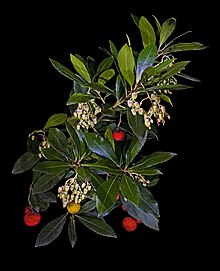
Manzanita is a common name for many species of the genus Arctostaphylos. They are evergreen shrubs or small trees present in the chaparral biome of western North America, where they occur from Southern British Columbia and Washington to Oregon, California, Utah, Arizona, New Mexico, and Texas in the United States, and throughout Mexico. Manzanitas can live in places with poor soil and little water. They are characterized by smooth orange or red bark and stiff, twisting branches. There are 105 species and subspecies of manzanita, 95 of which are found in the Mediterranean climate and colder mountainous regions of California, ranging from ground-hugging coastal and mountain species to small trees up to 20 feet (6m) tall. Manzanitas bloom from winter to early spring and carry berries in spring and summer. The berries and flowers of most species are edible.

Arctostaphylos is a genus of plants comprising the manzanitas and bearberries. They are shrubs or small trees.
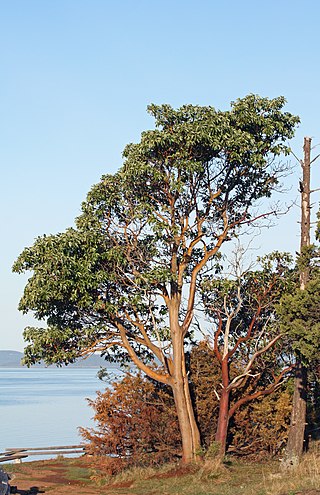
Arbutus menziesii or Pacific madrone, is a species of broadleaf evergreen tree in the family Ericaceae, native to the western coastal areas of North America, from British Columbia to California. It is nicknamed the "Refrigerator Tree" due to the fact that its bark contains water, and it stays cool in the summer.

Archibald Menzies was a Scottish surgeon, botanist and naturalist. He spent many years at sea, serving with the Royal Navy, private merchants, and the Vancouver Expedition. He was the first recorded European to reach the summit of the Hawaiian volcano Mauna Loa and introduced the Monkey Puzzle tree to England.
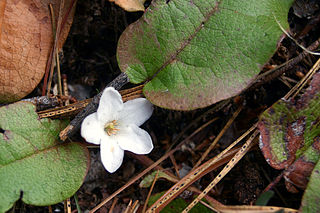
Epigaea is a small genus of flowering plant in the family Ericaceae. The species are small creeping shrubs that are typically anywhere from 10 to 20 cm tall at full growth, forming large patches. The leaves are evergreen, alternate and simple, ranging amongst the three species from 2 to 10 cm long. The flowers are small, white or pink, with a five-lobed tubular corolla which is produced in mid-spring. The fruit is a dry capsule with numerous small seeds.

Arbutus unedo is an evergreen shrub or small tree in the family Ericaceae, native to the Mediterranean Basin and Western Europe. The tree is well known for its fruits, the arbutus berry, which bear some resemblance to the strawberry, hence the common name strawberry tree. However, it is not closely related to true strawberries of the genus Fragaria.

The Northern California coastal forests are a temperate coniferous forests ecoregion of coastal Northern California and southwestern Oregon.
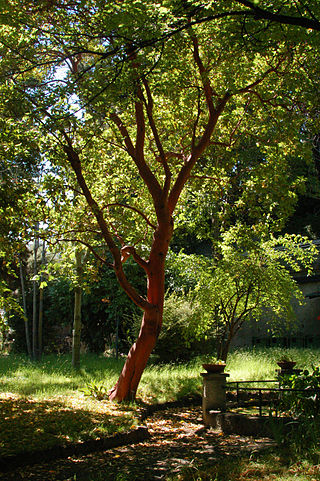
Arbutus andrachne, commonly called the Greek strawberry tree, is an evergreen shrub or small tree in the family Ericaceae, native to the Mediterranean region and the Middle East.

Arbutus canariensis, known in Spanish as madroño canario, is a species of shrub or tree in the heath family. It is endemic to the Canary Islands of Spain, specifically Tenerife, La Gomera, Gran Canaria, El Hierro, and La Palma. It is threatened by habitat loss.

Arbutus xalapensis, commonly known as the Texas madrone, Amazaquitl, or Texas madroño, is a species of flowering plant in the heather family. It is native to Central America, the southwestern United States, and throughout Mexico. It is found in canyons and mountains, on rocky plains, and in oak woodlands, at altitudes of up to 3,000 m in the south of the range, but lower, down to 600 m in the north of the range.
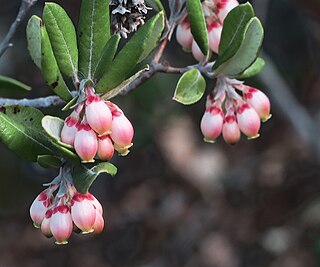
Xylococcus is a monotypic genus of flowering plants in the heather family which contains the single species Xylococcus bicolor, commonly known as the mission manzanita. It is a burl-forming, evergreen shrub to tree with leathery leaves and smooth dark reddish bark. From December to February, white to pink urn-shaped flowers adorn the foliage, often attracting hummingbird pollinators. It is native to southern California and the Baja California Peninsula, south to the Sierra de la Giganta. There is growing concern over the future of this plant, referred to as the "queen of the elfin forest, " as it may possibly lose up to 88% of its habitat and its wild seedlings are failing to survive more than a full year.
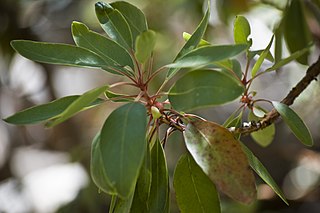
Arbutus arizonica, commonly known as Arizona madrone, is a tree species in the heath family that is native to the southwestern United States and northwestern Mexico. Its range extends along the Sierra Madre Occidental cordillera from the Madrean Sky Islands of southeastern Arizona and southwestern New Mexico south as far as Jalisco. It has been found in Sonora, Chihuahua, Durango, and Sinaloa, with one isolated population in Tamaulipas.
Strawberry tree is a common name for:

The Arbutoideae are a subfamily in the plant family Ericaceae. Phylogenetic analysis supported all genera of the subfamily as monophyletic, except Arbutus. Moreover, it was suggested that the non-sister relationship between Mediterranean and North American species may be explained by a once widespread distribution in the Northern hemisphere before the Neogene.
Arbutus occidentalis or the Mexican Madrone is a small tree species in the heath family, that is endemic to Mexico. It is only known from a few areas in Western Mexico where it grows on rocky slopes. It produces red edible berries that are valuable food to wildlife.

Arbutus × andrachnoides, the hybrid strawberry-tree, is the result of a cross between Arbutus andrachne and Arbutus unedo. It is a naturally occurring hybrid, but hybrid cultivars have also been created. It has gained the RHS's Award of Garden Merit.
El Potosí National Park is a protected area in northwestern Mexico. It is located in San Luis Potosí.It has an area of 20 km2.
